Designers: Allison Finley, Drew Masters, Inka Johnson, Radu Darie
Client Coordinator: Ashley Thomas, Bridge II Sports
Supervising Professor: Dr. Larry Bohs
INTRODUCTION
The client is young man with a budding DJ business. Because he has Morquio syndrome, he uses a wheelchair and needs substantial assistance to transport and set up his DJ equipment. The BeatMobile is designed to maximize his independence. It features a wheeled cart frame that allows him to transport his equipment with his electric scooter, a lighting system to display lights at an elevated height during shows, and a ramp and winch system for loading and unloading the loaded cart into his van. Using the BeatMobile, the client can set up his equipment in less than half the original time, with minimal assistance.
SUMMARY OF IMPACT
The BeatMobile supports the complete functionality of the client’s DJ equipment and eases the performance and set-up process. The client commented that he was “very excited to use the device,” and his mother said, “[I am] very grateful for the BeatMobile because [I] will not always be there to help set up for performances.”
TECHNICAL DESCRIPTION
The Beatmobile (Fig. 1) comprises a cart base, lighting truss, trailer bearing, ramp and winch system, and electrical connections for the client’s DJ equipment. The cart base is constructed from commercial metal shelving units and legs (InterMetro). Custom aluminum braces on the sides and back of the cart provide additional stability. Locking 3” diameter casters allow the cart to roll easily but be stable once in location.
The tabletop of the cart base extends to allow additional legroom when the client is seated. Black ABS plastic mounted on the tabletop provides a smooth surface for the client’s laptop and mixing table. Custom wooden speaker pockets mount to the bottom of the cart base with aluminum brackets, preventing the speakers from moving during transport.
Modular lighting poles, modified from commercial shower rods, support the lighting system. The two-part telescoping aluminum poles are light and easily assembled by the client, as the top lighting pole inserts into the bottom pole and locks with a pin. A steel lighting truss, modified from a commercial hanger rail (thecontainerstore.com, item 483050), holds the clients DJ lights. Steel cylinders welded to the truss ends connect the truss to the lighting poles and prevent lateral movement of the truss. The truss is raised and lowered using a trailer-winch hand crank (Overton) attached to the side of the cart and a pulley system. When the truss is raised, the lights are displayed at a height of seven feet. A release mechanism on the winch allows the lighting truss to be safely lowered for attachment and detachment of lights.
A custom trailer hitch allows the cart to be towed by the client’s electric scooter. The hitch includes a bearing that allows the cart to easily turn and roll over uneven terrain. A wire lock pin connects the hitch assembly to the receiver of the client’s scooter.
A commercial 7’ ramp (Trifold Advantage Series) is included for loading the Beatmobile into the client’s van, using a commercial 12V winch connected to the van’s battery. The hook on the winch cable connects to a screw eye on the side of the cart. A custom bracket quickly and securely attaches the winch to bolts mounted on the floor of the van.
Cables for the DJ equipment are pre-wired into the base of the cart, reducing set-up time and providing a neat appearance. Two surge protectors provide electrical connections for all of the DJ equipment, and all power cords connect to an extension cord reel on the base of the cart, with a GFI receptacle for safety in outdoor settings.
Figure 2 shows the client using the BeatMobile. The cost of the components for the device is approximately $430.


[…] Download Image More @ sites.duke.edu […]